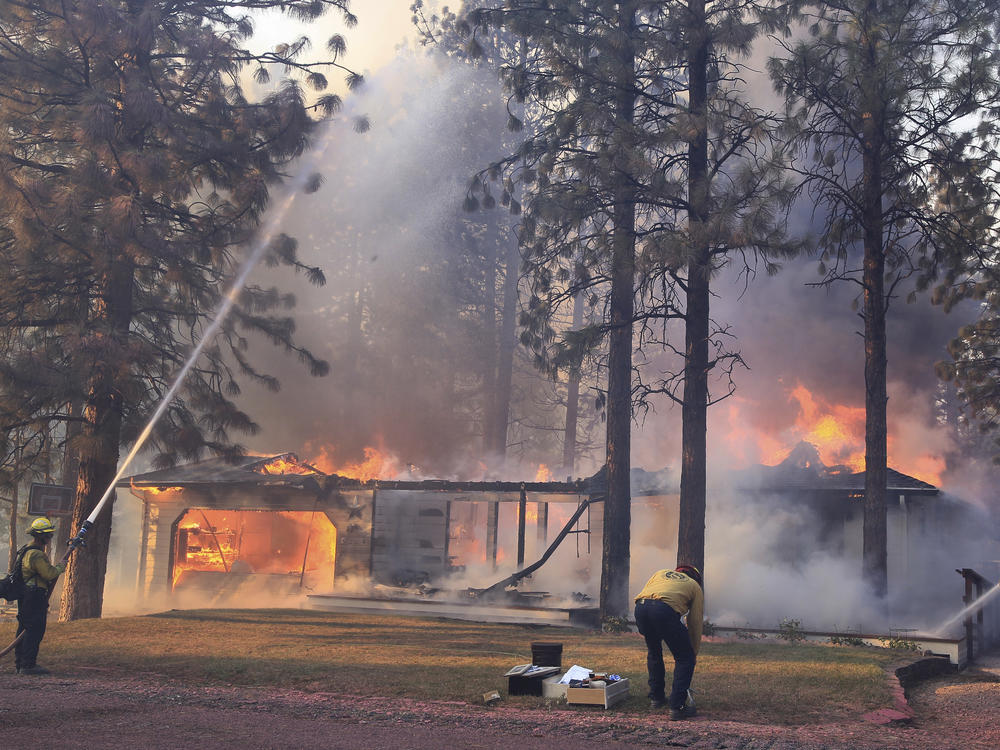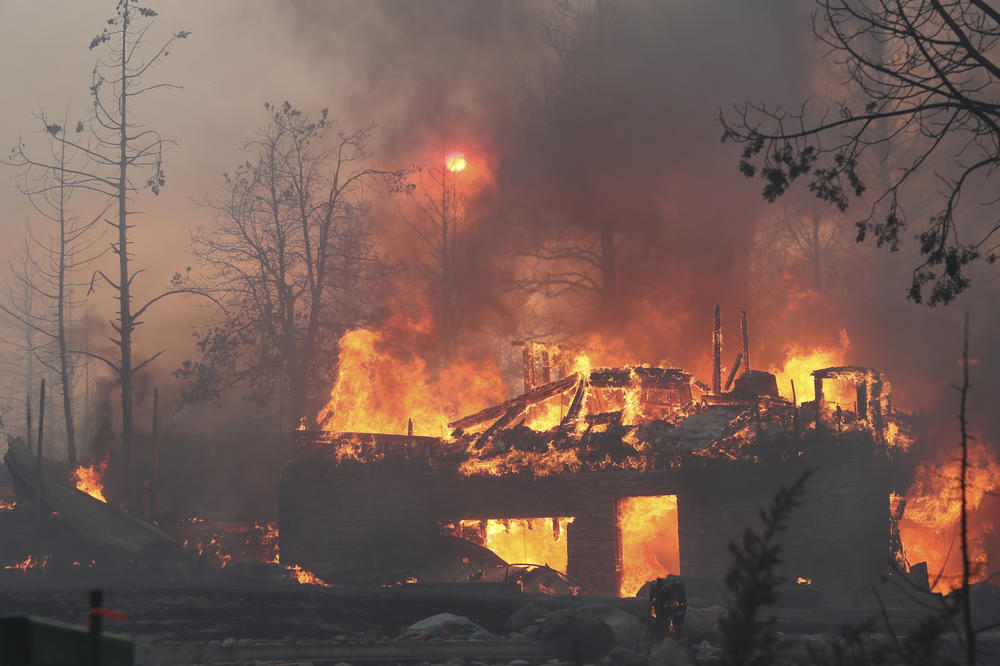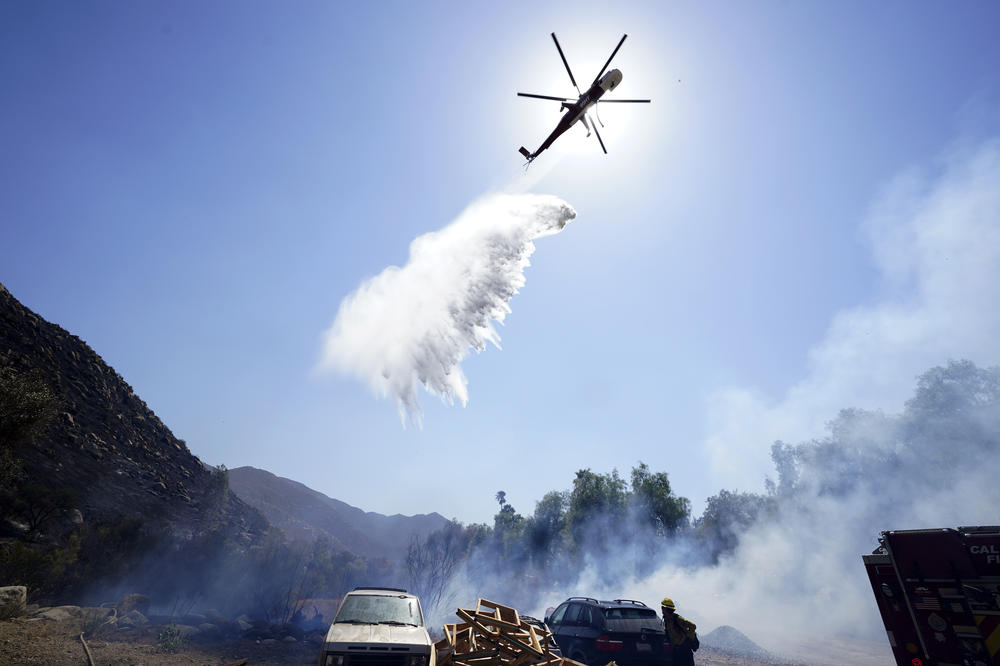Section Branding
Header Content
A Northern California wildfire has injured several people and destroyed homes
Primary Content
WEED, Calif. — Thousands of people remained under evacuation orders Saturday after a wind-whipped wildfire raged through rural Northern California, injuring people and torching an unknown number of homes.
The fire that began Friday afternoon on or near a wood-products plant quickly blew into a neighborhood on the northern edge of Weed but then carried the flames away from the city of about 2,600.
Evacuees described heavy smoke and chunks of ash raining down.
Annie Peterson said she was sitting on the porch of her home near Roseburg Forest Products, which manufactures wood veneers, when "all of a sudden we heard a big boom and all that smoke was just rolling over toward us."
Very quickly her home and about a dozen others were on fire. She said members of her church helped evacuate her and her son, who is immobile. She said the scene of smoke and flames looked like "the world was coming to an end."
Suzi Brady, a Cal Fire spokeswoman, said several people were injured.
Allison Hendrickson, spokeswoman for Dignity Health North State hospitals, said two people were brought to Mercy Medical Center Mount Shasta. One was in stable condition and the other was transferred to UC Davis Medical Center, which has a burn unit.
Rebecca Taylor, communications director for Roseburg Forest Products based in Springfield, Oregon, said it is unclear if the fire started near or on company property. A large empty building at the edge of company property burned she said. All employees were evacuated, and none have reported injuries, she said.
The blaze, dubbed the Mill Fire, was pushed by 35-mph (56-kph) winds, and quickly engulfed 4 square miles (10.3 square kilometers) of ground.
The flames raced through tinder-dry grass, brush and timber. About 7,500 people in Weed and several nearby communities were under evacuation orders.
Dr. Deborah Higer, medical director at the Shasta View Nursing Center, said all 23 patients at the facility were evacuated, with 20 going to local hospitals and three staying at her own home, where hospital beds were set up.
Gov. Gavin Newsom declared a state of emergency for Siskyou County and said a federal grant had been received "to help ensure the availability of vital resources to suppress the fire."
At about the time the blaze started, power outages were reported that affected some 9,000 customers, and several thousand remained without electricity late into the night, according to an outage website for power company PacifiCorp, which said they were due to the wildfire.
Wildfires force evacuations across California
It was the third large wildfire in as many days in California, which has been in the grip of a prolonged drought and is now sweltering under a heat wave that was expected to push temperatures past the 100-degree mark in many areas through Labor Day.
Thousands also were ordered to flee on Wednesday from a fire in Castaic north of Los Angeles and a blaze in eastern San Diego County near the Mexican border, where two people were severely burned and several homes were destroyed. Those blazes were 56% and 65% contained, respectively, and all evacuations had been lifted.
The heat taxed the state's power grid as people tried to stay cool. For a fourth day, residents were asked to conserve power Saturday during late afternoon and evening hours.
The Mill Fire was burning about an hour's drive from the Oregon state line. A few miles north of the blaze, a second fire erupted Friday near the community of Gazelle. The Mountain Fire has burned more than 2 square miles (6 square kilometers) but no injuries or building damage was reported.
The whole region has faced repeated devastating wildfires in recent years. The Mill Fire was only about 30 miles (48 kilometers) southeast of where the McKinney Fire — the state's deadliest of the year — erupted in late July. It killed four people and destroyed dozens of homes.
Olga Hood fled her Weed home on Friday as smoke was blowing over the next hill.
With the notorious gusts that tear through the town at the base of Mount Shasta, she didn't wait for an evacuation order. She packed up her documents, medication and little else, said her granddaughter, Cynthia Jones.
"With the wind in Weed everything like that moves quickly. It's bad," her granddaughter, Cynthia Jones, said by phone from her home in Medford, Oregon. "It's not uncommon to have 50 to 60 mph gusts on a normal day. I got blown into a creek as a kid."
Hood's home of nearly three decades was spared from a blaze last year and from the devastating Boles Fire that tore through town eight years ago, destroying more than 160 buildings, mostly homes.
Hood wept as she discussed the fire from a relative's house in the hamlet of Granada, Jones said. She wasn't able to gather photos that had been important to her late husband.
Scientists say climate change has made the West warmer and drier over the last three decades and will continue to make weather more extreme and wildfires more frequent and destructive. In the last five years, California has experienced the largest and most destructive fires in state history.
Copyright 2022 NPR. To see more, visit https://www.npr.org.



